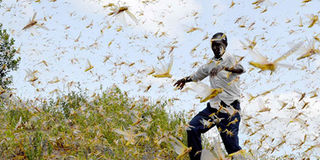Battle against desert locusts almost won, UN agency says

A local in Kiplekwa village, Baringo County, tries to chase away desert locusts on February 23, 2019. PHOTO | FILE | NATION MEDIA GROUP
What you need to know:
- Eight months after the locust invasion, FAO on Tuesday said only Samburu and Turkana counties are still battling the destructive swarms.
- The remaining 27 regions have contained the menace, the agency said.
The UN Food and Agriculture Organisation (FAO) says Kenya is just three weeks away from eliminating the desert locust menace.
Eight months after the locust invasion, FAO on Tuesday said only Samburu and Turkana counties are still battling the destructive swarms.
The remaining 27 regions have contained the menace, the agency said.
Samburu special programmes head Daniel Lesaigor said out of the 516 swarms the county surveillance team has been monitoring, only two remain.
“We sprayed what we thought was the last swarm on Sunday but two more were spotted the following day. The fight against the locusts has been largely won,” Mr Lesaigor told the Nation.
“We are not safe yet because the insects are highly migratory.”
Mr Lesaigor said aerial and ground spraying eliminated 316 swarms.
He expressed concern that the winds blowing from north, especially Ethiopia, could bring in swarms.
“That is why we are still training surveillance teams. We do not want to be caught offguard,” he said.
Turkana County, declared by the UN as the epicentre of desert locust menace in Kenya early this month, has also recorded a significant reduction in swarms.
FAO Resilience team leader for East Africa Cyril Ferrand said the threat of possible invasion towards the end of the year will call for continued surveillance.
He said the biggest problem teams like his face is the mobility of the locusts.
“We need to be agile when following the mature and juvenile desert locust swarms. A swarm can cover up to 150 kilometres a day. This requires pesticides, planes, helicopters, fuel and teams on the ground doing the scouting and surveillance,” he added.
Mr Ferrad said the coronavirus pandemic has made training scouts difficult. Social distance has to be kept and many people cannot be trained at the same time.
FAO estimates the harvest losses as a result of the insects at more than Sh200 billion.
According to the Desert Locust Control Organisation for Eastern Africa (DLCO), the insect has a lifespan of up to 10 months.
“Desert locusts damage wild and cultivated vegetation. One insect can consume its own weight of fresh vegetation a day. That means half a million locusts – each weighing two grammes – will eat about a tonne of vegetation daily. This amount is enough to feed 2,500 people,” DLCO says on its website.
The invasion started in Turbi, and parts of Isiolo during the Christmas period last year.





